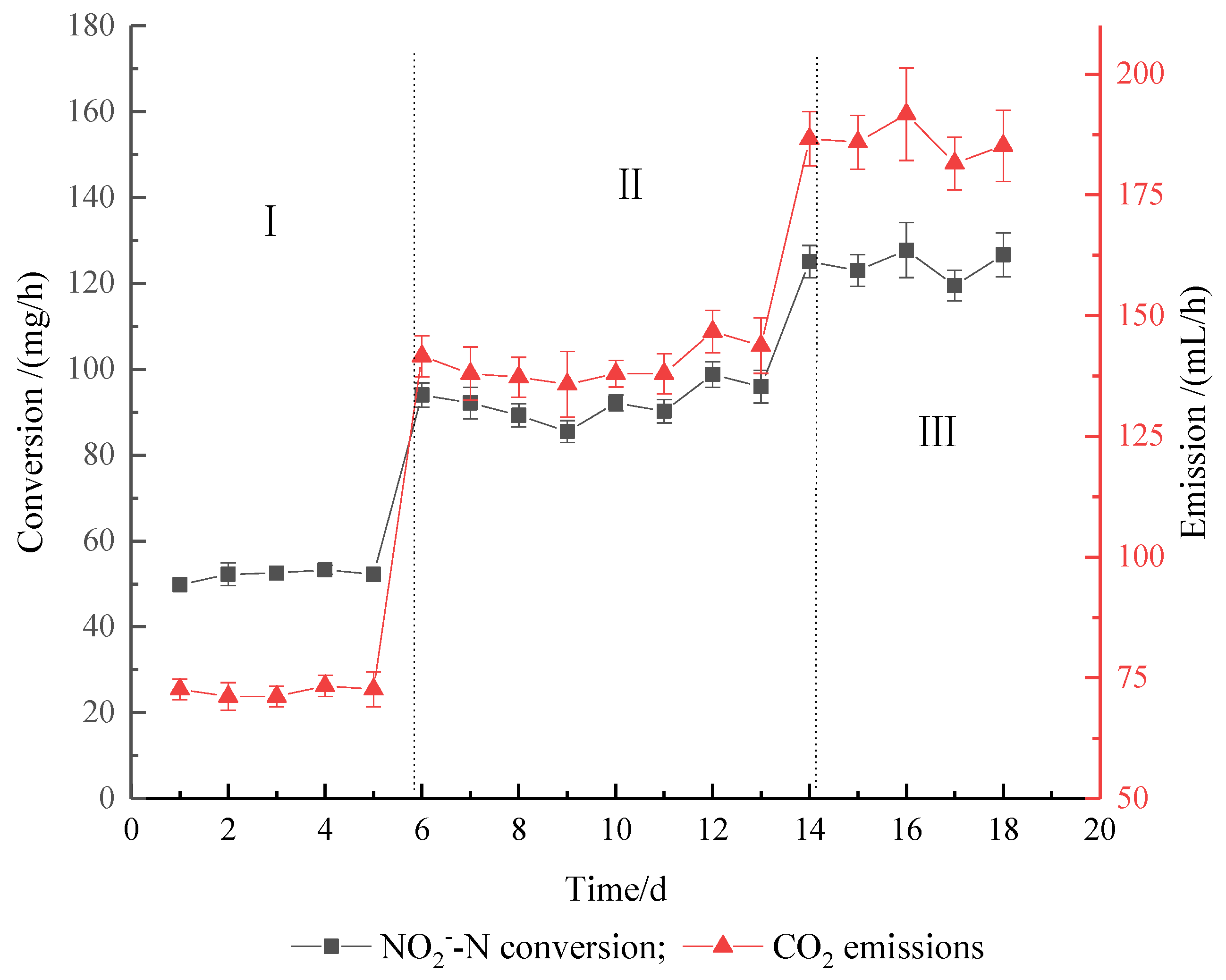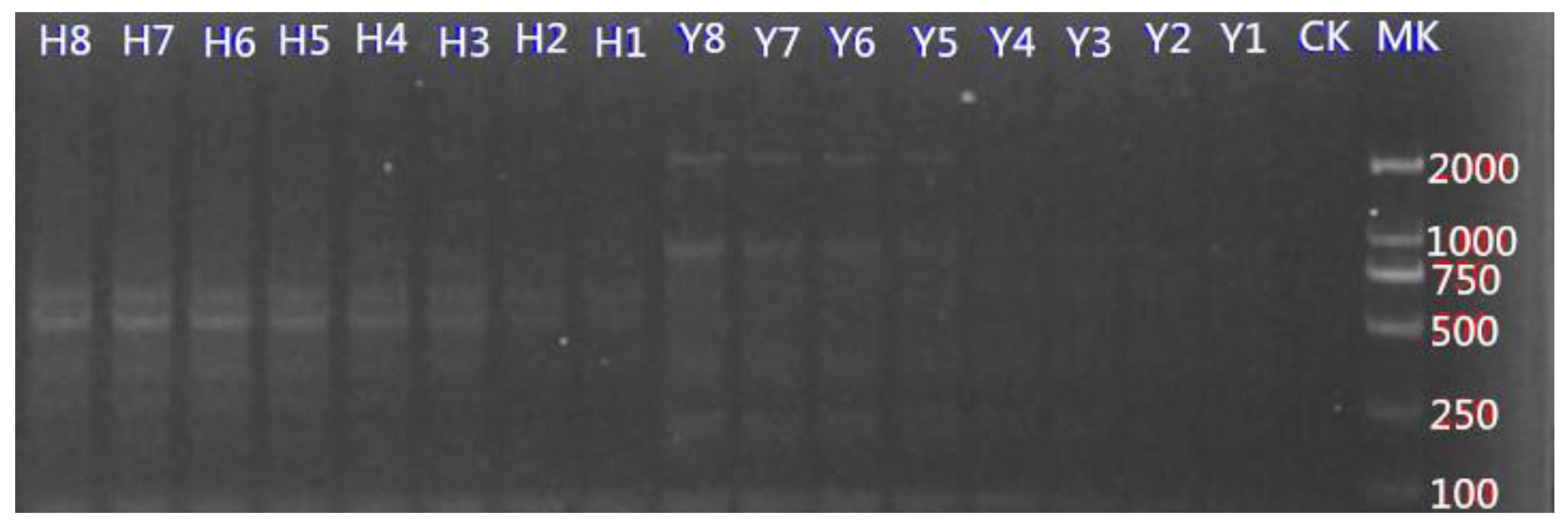Effect of Hydraulic Retention Time on Carbon Sequestration during the Two-Stage Anammox Process
Abstract
:1. Introduction
2. Materials and Methods
2.1. Setup of Experimental Reaction
2.2. Inoculated Sludge and Experimental Wastewater
2.3. HRT Experimental Procedure
2.4. Analytical Method
2.4.1. General Indicator Analysis
2.4.2. DNA Extraction
2.4.3. PCR Technology
2.4.4. Microbial Analysis
3. Results and Discussion
3.1. Partial Nitrification Experiment
3.2. Anaerobic Ammonium Oxidation Experiment
3.3. DNA Extraction Test Results
3.4. PCR Technology
4. Conclusions and Outlook
Author Contributions
Funding
Acknowledgments
Conflicts of Interest
References
- Okabe, S.; Oshiki, M.; Takahashi, Y.; Satoh, H. Development of long-term stable partial nitrification and subsequent anammox process. Bioresour. Technol. 2011, 102, 6801–6807. [Google Scholar] [CrossRef] [PubMed]
- Chamchoi, N.; Nitisoravut, S.; Schmidt, J.E. Inactivation of anammox communities under concurrent operation of anaerobic ammonium oxidation (anammox) and denitrification. Bioresour. Technol. 2008, 99, 3331–3336. [Google Scholar] [CrossRef] [PubMed]
- Park, J.; Yamashita, N.; Wu, G.; Tanaka, H. Removal of pharmaceuticals and personal care products by ammonia oxidizing bacteria acclimated in a membrane bioreactor: Contributions of cometabolism and endogenous respiration. Sci. Total Environ. 2017, 605–606, 18–25. [Google Scholar] [CrossRef] [PubMed]
- Donald, S.; Beverley, C. A cross-site comparison of factors influencing soil nitrification rates in northeastern USA forested watersheds. Ecosystems 2009, 12, 158–178. [Google Scholar]
- Magalhaes, C.; Kiene, R.; Buchan, A. A novel inhibitory interaction between dimethylsulfoniopropionate (DMSP) and the denitrification pathway. Biogeochemie 2012, 17, 393–408. [Google Scholar] [CrossRef]
- Stein, L.Y.; Yung, Y.L. Production, isotopic composition, and atmospheric fate of biologically produced nitrous oxide. Annu. Rev. Earth Planet. Sci. 2003, 31, 329–356. [Google Scholar] [CrossRef]
- Wenjie, Z.; Huaqin, W.; Joseph, D.R.; Yue, J. Granular activated carbon as nucleus for formation of Anammox granules in an expanded granular-sludge-bed reactor. Glob. NEST J. 2015, 17, 508–514. [Google Scholar]
- Yue, J.; Dunqiu, W.; Wenjie, Z. Treatment of high-strength ammonia containing wastewater using partial nitritation system with biological selector. Glob. NEST J. 2015, 17, 738–743. [Google Scholar]
- Li, H.S.; Zhou, S.Q.; Qin, Y.J.; Long, J.Y. Fast startup of one-stage nitritation-ANAMMOX reactor for high-rate nitrogen removal from mature landfill leachate. Desalin. Water Treat. 2019, 149, 1–10. [Google Scholar] [CrossRef]
- Wei, D.; Ngo, H.H.; Guo, W.; Xu, W.; Du, B.; Wei, Q. Partial nitrification granular sludge reactor as a pretreatment for anaerobic ammonium oxidation (Anammox): Achievement, performance and microbial community. Bioresour. Technol. 2018, 269, 25–31. [Google Scholar] [CrossRef]
- Kartal, B.; Kuenen, J.G.; van Loosdrecht, M.C. Sewage Treatment with Anammox. Science 2010, 328, 702–703. [Google Scholar] [CrossRef] [PubMed]
- Strous, M.; Fuerst, J.A.; Kramer, E.H.; Logemann, S.; Muyzer, G.; van de Pas-Schoonen, K.T.; Webb, R.; Kuenen, J.G.; Jetten, M.S.M. Missing lithotroph identified as new planctomycete. Nature 1999, 400, 446–449. [Google Scholar] [CrossRef] [PubMed]
- Wang, Y.N.; Tsang, Y.F.; Wang, L.; Fu, X.; Hu, J.; Li, H.; Le, Y. Inhibitory effect of self-generated extracellular dissolved organic carbon on carbon dioxide fixation in sulfur-oxidizing bacteria during a chemoautotrophic cultivation process and its elimination. Bioresour. Technol. 2018, 252, 44–51. [Google Scholar] [CrossRef] [PubMed]
- Wang, B.; Li, Y.; Wang, D.; Liu, R.; Wei, Z.; Ren, N. Simultaneous coproduction of hydrogen and methane from sugary wastewater by an “ACSTRH–UASBMet” system. Int. J. Hydrogen Energy 2013, 38, 7774–7779. [Google Scholar] [CrossRef]
- Miao, Y.; Liang, Z.; Yang, Y. Start-up of single-stage partial nitrification-anammox process treating low-strength swage and its restoration from nitrate accumulation. Bioresour. Technol. 2016, 218, 771–779. [Google Scholar] [CrossRef]
- Imura, Y.; Isaka, K.; Kazama, F. Effects of inorganic carbon limitation on anaerobic ammonium oxidation (anammox) activity. Bioresour. Technol. 2011, 102, 4390–4394. [Google Scholar]
- Carty, P.L.; Bae, J.; Kim, J. Domestic wastewater treatment as a net energy producer-can this be achieved. East. Stand. Time 2011, 45, 7100–7106. [Google Scholar]
- Dai, W.; Xu, X.; Liu, B.; Yang, F. Toward energy-neutral wastewater treatment: A membrane combined process of anaerobic digestion and nitritation–anammox for biogas recovery and nitrogen removal. Chem. Eng. J. 2015, 279, 725–734. [Google Scholar] [CrossRef]
- Hao, X.; Liu, R.; Huang, X. Evaluation of the potential for operating carbon neutral WWTPs in China. Water Res. 2015, 87, 424–431. [Google Scholar] [CrossRef] [PubMed]
- Reardon, D.J.; Falk, M.W. Getting to Zero: Sustainability Best practices to Significantly Reduce Greenhouse Gas and Energy at Your Wastewater Facility. Proc. Water Environ. Fed. 2010, 13, 3347–3358. [Google Scholar] [CrossRef]
- Zhang, W.; Zhang, Y.; Li, L. Fast start-up of expanded granular sludge bed (EGSB) reactor using stored Anammox sludge. Water Sci. Technol. 2014, 69, 1469–1474. [Google Scholar]
- Zhang, W.; Wang, D.; Jin, Y. Effects of inorganic carbon on the nitrous oxide emissions and microbial diversity of an anaerobic ammonia oxidation reactor. Bioresour. Technol. 2018, 250, 124–130. [Google Scholar] [CrossRef] [PubMed]
- Zhang, Z.; Liu, S.; Miyoshi, T. Mitigated membrane fouling of anammox membrane bioreactor by microbiological immobilization. Bioresour. Technol. 2016, 201, 312–318. [Google Scholar] [CrossRef] [PubMed] [Green Version]
- APHA. Standard Methods for the Examination of Water and Wastewater, 19th ed.; American Public Health Association: Washington, DC, USA, 1995; p. 1467. [Google Scholar]
- Dapena-Mora, A.; Campos, J.L.; Mosquera-Corral, A.; Jetten, M.S.M.; Mendez, R. Stability of the ANAMMOX process in a gas-lift reactor and a SBR. J. Biotechnol. 2004, 110, 159–170. [Google Scholar] [CrossRef]
- Wang, X.T.; Jiang, Z.X.; Li, Y. Inorganic carbon sequestration and its mechanism of coastal saline-alkali wetlands in Jiaozhou Bay, China. Geoderma 2019, 351, 221–234. [Google Scholar] [CrossRef]
- Stephen, W.R.; Harland, G.W. Enzymology of the Acetyl-CoA pathway of CO2 fixation. Crit. Rev. Biochem. Mol. Biol. 1991, 26, 261–300. [Google Scholar]
- Mulder, A.; Van De Graaf, A.A.; Robertson, L. Anaerobic ammonium oxidation discovered in a denitrifying fluidized-bed reactor. FEMS Microbiol. Ecol. 1995, 16, 177–183. [Google Scholar] [CrossRef]
- Schouten, S.; Strous, M.; Kuypers, M.M.M. Stable car-bon isotopic fractionations associated with inorganic car-bon fixation by anaerobic ammonium-oxidizing bacteria. Appl. Environ. Microb. 2004, 70, 3785–3788. [Google Scholar] [CrossRef]
- Hugler, M.; Sievert, S.M. Beyond the calvin cycle: Autotrophic carbon fixation in the ocean. Ann. Rev. Mar. Sci. 2011, 3, 261–289. [Google Scholar] [CrossRef]
- Hao, X.; Joseph, J.; Mark, C.M. Model-based evaluation of temperature and inflow variations on a partial nitrification ANAMMOX biofilm process. Water Res. 2002, 36, 4839–4849. [Google Scholar] [CrossRef]
- Wang, H.; Han, J.; Zhang, W. Effects of NH4+-N and NO2−-N on carbon fixation in an anaerobic ammonium oxidation reactor. J. Environ. Manag. 2019, 241, 450–457. [Google Scholar] [CrossRef] [PubMed]









| Gene | Primer | Positions | Sequence (5′-3′) | Target Segment Length (bp) |
|---|---|---|---|---|
| cbbLR1 | cbbLR1-F | 634~651 | AAG GAY GAC GAG AAC ATC | 820 |
| cbbLR1-R | 1435~1454 | TCG GTC GGS GTG TAG TTG AA | ||
| coxL | coxL-F | - | GGC GGC TT[C/T] GG[C/G] AA[C/G] AAG GT | 1260~1290 |
| coxL-R | - | [C/T]TC GA[T/C] GAT CAT CGG [A/G]TT GA |
| Number | A260 | A280 | 260/280 | 260/230 | Concentration (ng/μL) |
|---|---|---|---|---|---|
| Y0 | 0.303 | 0.163 | 1.86 | 1.21 | 15.1 |
| Y1 | 0.244 | 0.141 | 1.73 | 1.78 | 12.2 |
| Y2 | 0.392 | 0.237 | 1.65 | 1.81 | 19.6 |
| Y3 | 0.520 | 0.296 | 1.76 | 1.74 | 26.0 |
| H0 | 1.386 | 0.795 | 1.74 | 1.58 | 69.3 |
| H1 | 0.322 | 0.191 | 1.69 | 1.80 | 16.1 |
| H2 | 0.502 | 0.286 | 1.76 | 1.13 | 25.1 |
| H3 | 0.437 | 0.224 | 1.95 | 1.99 | 21.9 |
© 2019 by the authors. Licensee MDPI, Basel, Switzerland. This article is an open access article distributed under the terms and conditions of the Creative Commons Attribution (CC BY) license (http://creativecommons.org/licenses/by/4.0/).
Share and Cite
Ma, X.; Liu, X.; Xiang, B.; Zhang, W. Effect of Hydraulic Retention Time on Carbon Sequestration during the Two-Stage Anammox Process. Processes 2019, 7, 717. https://doi.org/10.3390/pr7100717
Ma X, Liu X, Xiang B, Zhang W. Effect of Hydraulic Retention Time on Carbon Sequestration during the Two-Stage Anammox Process. Processes. 2019; 7(10):717. https://doi.org/10.3390/pr7100717
Chicago/Turabian StyleMa, Xueyan, Xiaoning Liu, Bangdong Xiang, and Wenjie Zhang. 2019. "Effect of Hydraulic Retention Time on Carbon Sequestration during the Two-Stage Anammox Process" Processes 7, no. 10: 717. https://doi.org/10.3390/pr7100717





